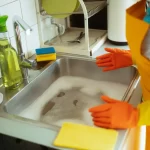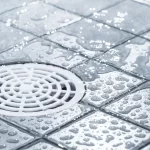Plumbing emergencies can strike without warning, often leading to significant damage and costly repairs if not addressed immediately. For homeowners and property owners in Toronto and the Greater Toronto Area (GTA), having a proactive approach to managing these emergencies is essential. This comprehensive guide will explore common plumbing emergencies, how to prevent them, and what steps to take if they occur.
1. Clogged Drains
Understanding the Problem: Clogged drains might seem like a minor inconvenience, but they can escalate into serious issues, especially if they involve critical systems such as main drains, eaves troughs, or sump pumps. A major clog can lead to flooding, which can cause extensive water damage and potentially compromise the structural integrity of your home.
Common Causes:
- Grease and Food Waste: Grease solidifies in pipes, while food waste can accumulate and create blockages.
- Hair and Soap Scum: These substances can combine and form a dense clog in bathroom drains.
- Foreign Objects: Items such as toys or sanitary products that are flushed or washed down the drain can cause blockages.
Signs to Watch For:
- Slow Drainage: Water taking longer than usual to drain can indicate an impending clog.
- Unpleasant Odors: Foul smells emanating from drains are often a sign of trapped waste or stagnant water.
- Gurgling Sounds: Unusual noises when water drains can signal a blockage in the system.
Preventive Measures:
- Regular Maintenance: Schedule periodic inspections and cleaning of your drains to prevent buildup.
- Use Drain Guards: Install mesh guards to catch debris before it enters the pipes.
- Avoid Chemical Cleaners: Harsh chemicals can sometimes exacerbate clogs or damage pipes. Opt for natural cleaning solutions like baking soda and vinegar.
What to Do:
- DIY Solutions: For minor clogs, use a plunger or a drain snake. These tools can often resolve blockages without professional help.
- Professional Help: If clogs persist, affect major systems, or if you encounter recurring issues, contact a professional plumber. They can perform a thorough inspection using advanced tools like hydro-jetting or camera inspections to identify and resolve the problem.
2. Frozen Pipes
Understanding the Problem: Frozen pipes pose a serious risk, as they can burst and lead to significant water damage. When water inside pipes freezes, it expands and creates pressure that can crack or rupture the pipes, resulting in costly repairs and potential flooding.
Common Causes:
- Extreme Cold Weather: Prolonged exposure to freezing temperatures can cause pipes to freeze.
- Inadequate Insulation: Pipes in unheated areas such as basements or crawl spaces are more susceptible to freezing.
- Heating Failures: Malfunctions in your home’s heating system can lead to freezing conditions.
Signs to Watch For:
- No Water Flow: If water flow stops or becomes weak during cold weather, your pipes may be frozen.
- Unusual Noises: Cracking or banging noises from your pipes can indicate that they are freezing.
- Visible Frost: Frost on exposed pipes or the exterior of pipes indicates freezing conditions.
Preventive Measures:
- Insulate Pipes: Use pipe insulation or heat tape on pipes located in unheated areas to protect them from freezing.
- Maintain Heat: Keep your home’s heating system at a consistent temperature, especially during extreme cold spells.
- Let Faucets Drip: Allowing a small trickle of water to flow through faucets can help prevent freezing.
What to Do:
- Thawing Pipes: If you suspect frozen pipes, use a hairdryer, space heater, or heat lamp to gently warm the affected area. Avoid using open flames or high heat, which can damage pipes or cause them to burst.
- Professional Help: If you’re unable to safely thaw the pipes or if you notice signs of a burst pipe, contact a plumber immediately. They can assess the damage and make necessary repairs.
3. Clogged Toilets
Understanding the Problem: Clogged toilets are one of the most common plumbing issues. While many clogs can be resolved with a plunger, more severe blockages or recurring issues may require professional intervention.
Common Causes:
- Excessive Toilet Paper: Flushing too much toilet paper can create blockages in the pipes.
- Foreign Objects: Items like sanitary products, wipes, or toys can obstruct the toilet.
- Tree Roots: Roots can invade sewer lines and cause clogs, particularly in older plumbing systems.
Signs to Watch For:
- Frequent Clogging: Regular clogs that cannot be cleared with a plunger indicate a more serious problem.
- Overflowing: If your toilet overflows or doesn’t flush properly, it signals a significant clog or issue with the drainage system.
- Slow Flushing: A toilet that flushes slowly may have a partial blockage or buildup in the pipes.
Preventive Measures:
- Proper Disposal: Avoid flushing non-flushable items and use toilet paper sparingly.
- Regular Inspection: Have your plumbing system checked periodically to identify potential issues before they become serious.
What to Do:
- DIY Solutions: Use a plunger for minor clogs. For more stubborn blockages, a toilet auger can help clear the obstruction.
- Professional Help: If clogs persist or you suspect something has been flushed that could cause significant damage, call a plumber. They can use specialized tools to clear the blockage and inspect the system for any underlying issues.
Emergency Preparedness
Have a Plan:
- Emergency Contact: Keep the contact information of a reliable emergency plumber in the GTA readily available. It’s crucial to have a trusted professional who can respond quickly to urgent situations.
- Know Your Shutoff Valves: Familiarize yourself with the location of your main water shutoff valve and learn how to turn it off. In the event of a plumbing emergency, shutting off the water supply can prevent further damage.
Act Quickly:
- Immediate Response: Address plumbing issues as soon as they arise. Delaying action can exacerbate the problem and increase repair costs.
- Damage Control: In case of flooding, move valuable items to higher ground and use towels or a wet/dry vacuum to manage water accumulation until help arrives.
By understanding common plumbing emergencies, implementing preventive measures, and knowing when to call in professionals, you can effectively manage and mitigate the impact of unexpected plumbing issues. Regular maintenance, quick action, and professional assistance are key to maintaining a safe and functional home.






